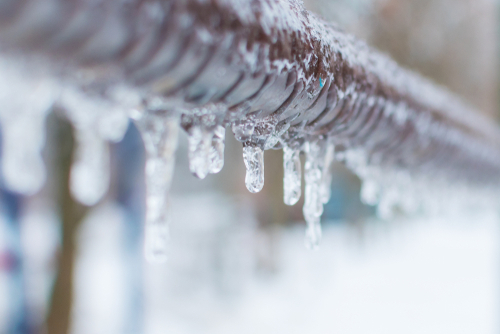Brrr! If you’re reading this, we’re guessing we’ve seen a cold snap kick in and the scarves, hats and gloves come out. Unfortunately, the drop in temperature means you might have another thing to add to your to-do list: sorting out frozen water pipes. Not ideal when the only thing you’ve been looking forward to all day is a long, hot soak. Luckily, there are things you can do to thaw your pipes and prevent them from freezing in the first place.
Prefer to watch?
How to tell whether your water pipes are frozen
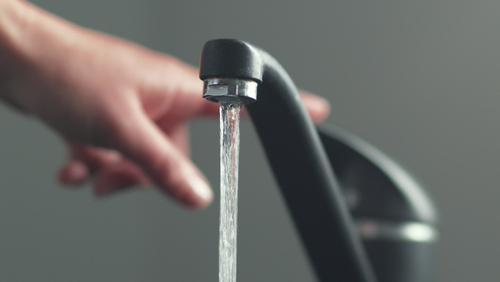
There’s some detective work you can do to determine whether your suspicions are correct:
- Run your kitchen and bathroom taps to see if any water comes out
- Flush your toilet a couple of times. Does the water refill? Even if your pipes are frozen you should be able to flush them once using the water already stored in the tank
- Listen for gurgling and clanging sounds — if your pipes are being noisy, this could be down to ice travelling through them
- Inspect the pipes — for condensation or bulging
- Keep an eye out for puddles, leaks, and other signs of a burst water pipe
What to do if you have a frozen water pipe
If you’re certain you’ve got a case of frozen pipes on your hands, there are a few things you should do straight away. If your pipes are frozen but do not burst, you may be able to thaw them yourself. If you suspect that a frozen pipe has burst, you should call a professionally trained plumber as soon as possible to arrange an emergency repair.
1. Check with your neighbours
If you’re having issues with your water supply, give your neighbours a bell and ask if they’re experiencing anything similar. If this is the case, there could be an issue with the mains water system. If you use a shared mains water connection and a pipe has burst, you might have to club together to arrange to have it fixed. In some instances, it will be up to the water company you use to organise the repair.
Don’t panic if, after speaking with the neighbours, you’ve deduced that it’s just yours that is causing havoc. We’ve gathered the key things you should do to unfreeze frozen water pipes.
2. Turn off the water supply
This will reduce the likelihood of pipes bursting and the volume of water that could escape from a crack. Your stop tap (also called a stopcock or stop valve) is the most straightforward way to cut off the water supply. This is usually located under the kitchen sink, but can also be found:
- In an airing cupboard
- In a basement or garage
- Under the stairs
- In a downstairs bathroom
- There may also be a built-in stop valve if you have a water meter
Once you’ve found it, turn your stop tap clockwise to cut off the water flow. If you’re taking a break over winter, it could be worth turning the water supply off, in case there’s prolonged cold weather while you’re away.
3. Locate the frozen pipe
We appreciate this is easier said than done considering our homes are full of pipes. Keep your eyes peeled for tell-tale signs like the pipe being very cold or starting to bulge or crack. You can also check if there’s a section of the pipe that’s colder than the rest — this should help you to identify if there’s a blockage of ice.
Another strategy is to inspect areas in your home which get less heat. Basements, attics, and unused rooms are all susceptible to frozen pipes. In some properties, the hot water tank is in the attic. Heat should rise from the rooms below; however, if there’s insulation under the tank but not around it, it won’t get the warmth it needs.
If you tested your taps, you’ll have found whether they’ve all stopped working or the problem lies with one of them. If none work, this suggests that the frozen pipe could be near the main water supply. If it’s just the bathroom tap that’s not playing ball, the frozen pipe may be the one that connects your sink to your main plumbing system.
If you suspect that the frozen pipe is located somewhere you can’t get to easily, we advise that you call a professional to thaw your pipes.
4. Thaw the pipe with a hot water bottle

Once you’ve found the culprit, it’s time to warm it up to thaw the ice inside. If, on the discovery of the frozen pipe, you’ve noticed its burst, don’t forget that you should call a plumber for assistance.
Before kicking off the thawing process, turn the taps on so the frozen water can escape once it starts to melt. Next, lay some towels on the floor in case there are any cracks you haven’t spotted, and water begins to leak.
Once you’re set, start to thaw the frozen pipe slowly and carefully, using any of the following:
- A towel or cloth soaked in hot water (the water should be hot, not boiling).
- A hot water bottle.
- A hairdryer — please note that you should never leave a hair dryer on and unattended. Always hold your hairdryer and keep it moving all over the pipe.
You should never use an electric heater or a blowtorch to unfreeze a pipe — these emit more heat than is necessary for the job and are dangerous to use.
5. Turn the water back on and check for signs of leaks
Once the pipe feels normal, run the tap to see if all that hard work has done the trick. Establish that there are no leaks, and the water is coming out of the tap as it should.
How to prevent your water pipes from freezing
You’ll be pleased to hear that there are a few things you can do to prepare your home for future spells of cold weather.
Insulate your pipes
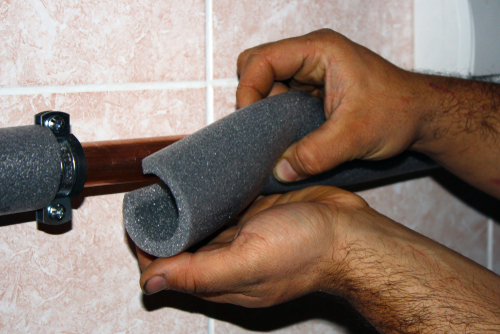
You can purchase something called ‘lagging’, which is a type of foam tube that fits snugly around pipes. Just like a fluffy winter coat, it provides insulation and protection from the cold. The foam tubes are suitable for both plastic and metal pipes — if you don’t know what thickness and length to use, we recommend getting help from your local DIY store.
If your home has an outdoor bib tap, a tap attached to the wall that allows you to connect the water supply to a garden hose, make sure this is shielded from the elements too. You can achieve this either with a tap cover or a box. If you can, it might also be worth shutting off the isolating valve (if you have one) on the water supply line that feeds the bib tap.
Check your taps aren’t dripping
You may have heard that letting a tap drip can stop pipes from freezing. In reality, a leaky tap won’t stop pipes freezing but it can make your drains freeze. That blockage might cause a flood or make your sink overflow, if you’re unlucky.
That’s why it’s important to check your indoor and outdoor taps aren’t dripping. If any are leaky, turn them fully off or get them repaired.
Insulate your water tank
If your house has a water tank, it needs to be wrapped up in an insulation jacket. At the same time, make sure the water tank in your loft isn’t sitting on insulation. That will stop heat rising from below, making the tank more vulnerable to cold weather.
Ensure your boiler is serviced regularly
When the temperature outside lowers, we rely on our boilers more to heat our homes. Naturally, we want to be confident they can handle this extra workload! It’s important to get yours serviced each year to make sure it’s running safely and efficiently. This way, there’s less of a chance of it packing it in over winter, leading to a cold house and frozen pipes.
If you’d like to find out more about boilers, boiler care plans, and annual services, have a look at our heating page.
Keep your home as warm as possible
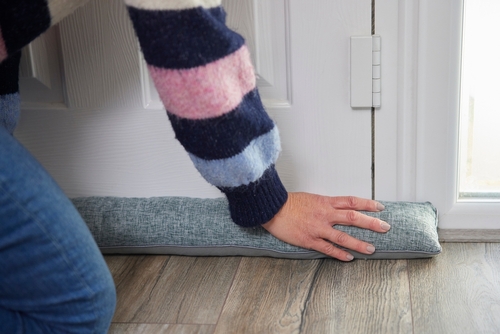
Try to insulate your home as much as you can. Draft-proof your windows and doors to keep the warm air in and the cold air out. Don’t forget about your front door either… get a metal disk to cover the keyhole and if it has a letterbox, check this is insulated with a brush, plate, or flap.
Powerflushing your radiators is another effective way to keep the heat in when the heat is on. This, along with other maintenance, ensures they’re working efficiently and less likely to break unexpectedly. You can read more about radiator maintenance and other hacks to keep your home warm in our guide.
More winter maintenance tips
Frozen pipes aren’t the only thing that can go wrong in winter. To avoid any nasty surprises, we recommend that you also:
- Check your roof for loose tiles
- Clear your gutters and replace any that are faulty
- Repair any weak points in fences, gates and sheds
- Get leaf-moving tools like a rake or blower
Finally, it’s wise to have supplies in case the power’s cut or you get snowed in. It’s good to have:
- A torch, candles and matches
- Plenty of batteries
- Tinned and frozen food
If you need any medication, it’s worth finding out if your pharmacy can deliver prescriptions.
Our blog is loaded with more related articles
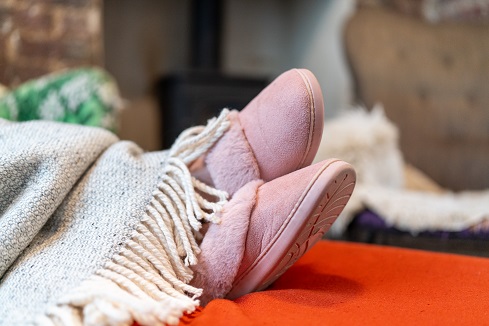
Energy saving tips
How to save energy at home in winter
The changes we’re suggesting are so small, you’ll forget you’ve made them — that is until you check you...
Read more
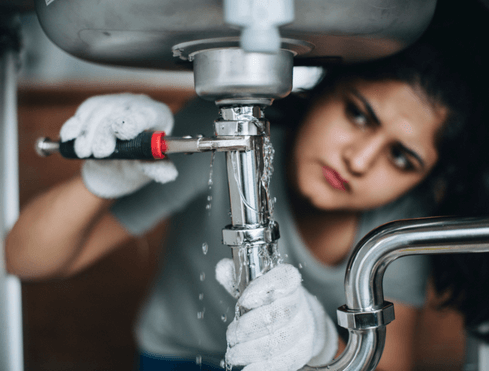
Plumbing and heating tips
Easy plumbing maintenance tips
Did you know that the earliest copper piping dates from an Egyptian pyramid built 4,500 years ago? Since plumbing has been arou...
Read more
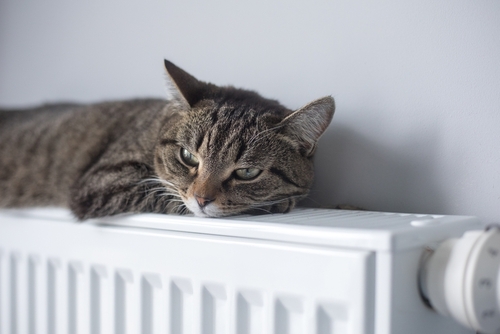
Plumbing and heating tips
How to keep your house warm in winter
From checking your thermostat to insulating your roof, here's our top tips to keeping your home warm in winter.
Read more
